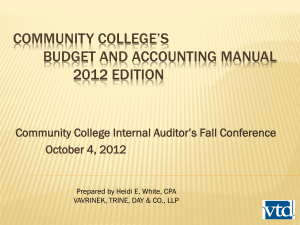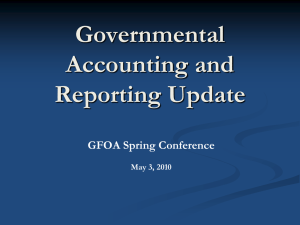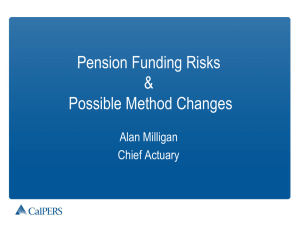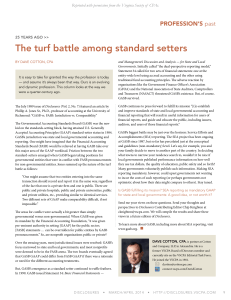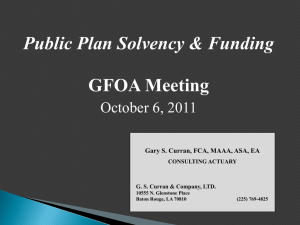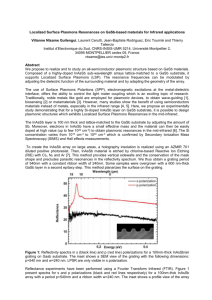Logical Implications of GASB's Methodology for - Robert Novy-Marx
advertisement
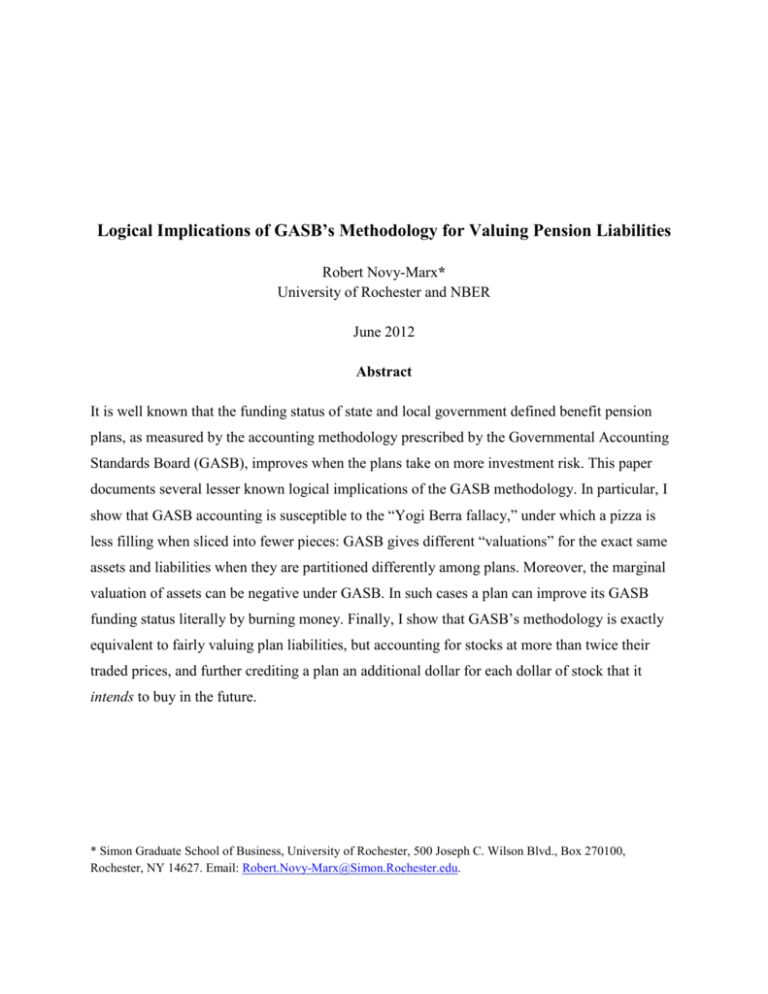
Logical Implications of GASB’s Methodology for Valuing Pension Liabilities Robert Novy-Marx* University of Rochester and NBER June 2012 Abstract It is well known that the funding status of state and local government defined benefit pension plans, as measured by the accounting methodology prescribed by the Governmental Accounting Standards Board (GASB), improves when the plans take on more investment risk. This paper documents several lesser known logical implications of the GASB methodology. In particular, I show that GASB accounting is susceptible to the “Yogi Berra fallacy,” under which a pizza is less filling when sliced into fewer pieces: GASB gives different “valuations” for the exact same assets and liabilities when they are partitioned differently among plans. Moreover, the marginal valuation of assets can be negative under GASB. In such cases a plan can improve its GASB funding status literally by burning money. Finally, I show that GASB’s methodology is exactly equivalent to fairly valuing plan liabilities, but accounting for stocks at more than twice their traded prices, and further crediting a plan an additional dollar for each dollar of stock that it intends to buy in the future. * Simon Graduate School of Business, University of Rochester, 500 Joseph C. Wilson Blvd., Box 270100, Rochester, NY 14627. Email: Robert.Novy-Marx@Simon.Rochester.edu. State and local government spending makes up one eighth of the US economy. Sub-national government entities employ one out of seven US workers, and these workers generally participate in state sponsored defined benefit (DB) pension plans. Many of these workers have no savings, and roughly 30% (mostly public safety workers) are not enrolled in Social Security, so these plans represent many public employees’ sole source of post-retirement income. Governments value their pension liabilities, which run to trillions of dollars, using a methodology prescribed by the Governmental Accounting Standards Board (GASB). These valuations are employed in planning and budgeting. Because they routinely provide the basis for multi-billion dollar decisions, their accuracy has direct implications for government efficiency. As a result, it is GASB’s expressed goal “to develop high-quality standards of accounting and financial reporting for the state and local governments… [which] lead to information in financial reports that improves transparency, assists in assessing accountability, and is useful for making important decisions” (GASB, 2011a). There remains substantial disagreement, however, regarding the validity of GASB’s prescribed methodology. While most public sector actuaries and the National Association of State Retirement Administrators support GASB’s methodology, academic economists disagree with its underlying principles with near unanimity. The heart of the disagreement lies with the rate used to discount liabilities. GASB discounts projected benefit payments at the expected return on plan assets, because the Board believes this rate “best reflects the employer’s projected sacrifice of resources” (GASB, 2011b). Financial economists prefer a lower discount rate, because accumulated pension promises are viewed as nearly default-free and the basic tenets of financial economics require that cash-flows are discounted at rates reflecting their risks. 1 1 Much of the actuarial and accounting professions actually support the economists’ position. The Financial Accounting Standards Board, the source of generally accepted accounting principles for the U.S. private sector, specifies that corporations calculate pension liabilities by discounting expected future benefit payments using high grade corporate bond yields. This basically treats pension debt in the same manner as firms’ other debts more generally. The Pension Protection Act of 2006 similarly specifies minimum funding requirements for DB pension plans using liability calculations that employ investment grade corporate bond rates. The Pension Benefit Guarantee Corporation bases the variable insurance premiums it charges plans on these same calculations. Finally, common practice in mergers and acquisitions involves calculating pension liabilities using a “settlement rate” that typically reflects the discount rate implicit in the market price of annuities, which are typically even lower than the yields on high grade corporate debt. 1 The difference in the aggregate liability posed by state and local DB pension plans calculated using the discount rates preferred by GASB and financial economists is enormous—in excess of two trillion dollars (Novy-Marx and Rauh 2008, 20011a, 2011b). The two methodologies also yield dramatically different conclusions regarding the annual cost of the new benefits accrued by workers each year. The cost of the new pension benefits earned by a state’s work force each year is roughly 12-14% of total payroll when calculated using GASB’s methodology, but averages more than twice that amount when calculated using the methodology preferred by financial economists (Novy-Marx and Rauh, 2011c). As a result, GASB underestimates the true cost of state and local government workers by almost a hundred billion dollars a year. The debate over the correct methodology for valuing government pension liabilities has been running for at least ten years (Bader, 2001, Bader and Gold, 2003). GASB supporters correctly assert that holding high average return assets reduces the expected future unfunded liability, and believe that this justifies recognizing lower unfunded liabilities today. Critics correctly assert that this allows plans to improve their GASB funding status simply by taking on more risk, despite the fact that this does not in any way alter the nature of their liabilities. While the economic and actuarial professions continue to actively debate the issues (on the pro-GASB side see, for example, Midlin, 2008, or Brainard, 2008; for GASB critiques see Brown and Wilcox, 2009, or Biggs, 2011), neither side is swayed by the other’s arguments. Economists are unlikely to convince the actuarial profession through appeals to covariances or state contingent pricing, while the actuarial profession will never convince economists to ignore the basic precepts of financial economics. This paper consequently takes a different approach, and simply illustrates some potentially problematic implications of the GASB methodology using elementary examples. First, I show that GASB is not really a valuation method. A valuation method should recognize that “more is more,” in the sense that adding a dollar to any given set of assets and liabilities increases the set’s value. It should also assign a unique value to a given set of assets and liabilities. The GASB methodology for accounting for net pension liabilities does not satisfy either of these conditions. Under GASB it is possible that a plan can improve its funding status by literally burning money. GASB recognizes that cash and bonds are valuable assets, but nevertheless penalizes a plan for 2 holding these, by forcing it to recognize a larger liability. Destroying a dollar (i.e., reducing its cash or bond holdings by a dollar while holding all other asset holdings fixed) reduces a plan’s assets by exactly a dollar, but can reduce its GASB liability by more than a dollar. In this case a plan can reduce its GASB recognized underfunding by destroying assets. Many states also sponsor multiple pension plans, and GASB gives different “values” for the exact same assets and liabilities depending on how these are partitioned across plans. As a result, a state can improve its GASB funding status simply by redistributing its assets and liabilities across plans, without altering the nature of either its liabilities or the assets that it holds. I also show that the methodology explicitly prescribed by GASB can be recast as an alternative, equivalent methodology, which entails discounting both a plan’s liabilities and the expected cash flows generated by its assets, as well as the expected cash flows of the assets it plans to buy in the future, at the rate used to discount high quality municipal bonds. Discounting the expected cash flows from a dollar of stock held in a typical DB pension plan yields a “valuation” of roughly two and a half dollars. The GASB methodology is therefore equivalent to valuing pension liabilities in the same manner used to value the states’ other long term liabilities, accounting for stocks at roughly two and a half times their traded prices, and further crediting plans making their actuarially determined contributions more than a dollar for each dollar of stock that they intend to buy in the future. The following pages describe each of these logical implications of the GASB methodology in greater detail, and illustrate them using simple examples. Improving GASB funding status by destroying money GASB presents managers of public pension plans with an unintended option for reducing their recognized liabilities. A plan can, under GASB logic, sometimes improve its funding status by literally burning money. This result holds because the marginal value of a dollar of assets, as measured by GASB, can be negative. By destroying a dollar’s worth of T-bills, or other cashequivalents, a manager decreases a plan’s assets, but increases the remaining assets’ expected returns. These higher asset returns decrease the plan’s liability, as recognized by GASB, and this decrease can more than offset the loss of assets. 3 This can be illustrated with a simple example. Consider two pension plans, plans “A” and “B.” Plan A has a single member, a 35 year old worker with five years of service who plans to retire in thirty years with a projected salary of $105,000. The plan holds $10,000 of stocks that have an expected return of 10%. Plan B also has a single member, identical in all ways to that in plan A, and holds the exact same stocks, but additionally owns $10,000 dollars worth of T-bills providing a risk-free yield of 4%. Common sense demands that plan B is better funded than plan A by exactly $10,000. Under GASB’s methodology, however, Plan A appears better funded than plan B. To see this, suppose the workers are promised annual post retirement payments equal to 2% of their final salaries for each year of service. This implies annual payments recognized under the projected benefit obligation (PBO) of $10,500 per year (5 x 2% x $105,000 / year) starting in thirty years. If life annuities for 65 year old retirees make annual payments of 6% of the initial investment, then each employee’s currently recognized PBO liability can be satisfied with a payment in thirty years of $175,00 ($10,500 / 0.06). Plan A is, under GASB rules, fully funded. The present value of its thirty year liability of $175,000, discounted at the 10% expected return on its assets, is $10,000, the same as the value of its stock market holdings. Plan B, however, has an unfunded liability of $3,000 dollars under GASB. Its thirty year liability of $175,000 discounted at the plan's 7% expected return on assets (½ x 4% + ½ x 10%) is $23,000, $3,000 more than the value of its stocks and bonds. Despite the fact that plan B is identical to plan A in every respect except for the additional $10,000 it holds, GASB methodology holds that it is $3,000 less well funded. That is, GASB rules imply that a plan that must make a $175,000 payment in 30 years and owns $10,000 in stocks is better funded than a plan with the same liability and the same stock holdings but that additionally owns $10,000 in bonds. Plan B can thus improve its GASB funding status by $3,000 by burning its bonds. Under proposed amendments to GASB’s rules on Accounting and Financial Reporting for Pensions (GASB 2011b), the plan that holds only stock would remain fully funded, while the plan that holds additional bonds would become even more underfunded. The proposals specify that projected benefit payments would be discounted using “(1) a long-term expected rate of 4 return on plan investments to the extent that plan net position is projected to be sufficient to pay pensions and the net position projected to remain after each benefit payment can be invested long-term and (2) a tax-exempt, high-quality municipal bond index rate to the extent that the conditions in (1) are not met” (GASB 2011a). 2 If adopted, this change would have no effect on the funding status of Plan A, because this plan’s “projected assets” are sufficient to pay its liabilities. It would cause a significant deterioration, however, in the funding status of plan B, the plan that holds an additional $10,000 in bonds. Plan B would be required to discount the projected 30 year funding shortfall of $23,000 ($175,000 – $20,000 x 1.0730) at a lower rate, the rate on high-quality municipal bonds. If municipal bonds yield the same 4% as T-bills, this would force the fund to report an unfunded liability of $7,000. The proposed amendments to GASB, designed to “improve the decision-usefulness of information in employer financial reports,” would therefore make Plan B, which is self-evidently $10,000 better funded than Plan A, report that it was an additional $4,000 less well funded. In the technical literature on “coherent” risk measures, started by Artzner et.al. (1999), this feature of GASB accounting represents an acute violation of the axiom of “translation invariance.” This axiom basically posits that a risk measure cannot be considered coherent unless the addition of a dollar’s worth of risk-free assets to any portfolio reduces the portfolio’s risk by exactly a dollar. Appendix A.1 provides a more detailed discussion of GASB’s relation to the concept of “coherent” measures of risk. GASB and the Yogi Berra Fallacy GASB’s methodology for calculating pension liabilities is not strictly a valuation methodology, as it does not assign a unique value to a given set of assets and liabilities. The methodology is susceptible to the “Yogi Berra Fallacy,” assigning different values to the exact same assets and liabilities when these are partitioned in different ways across plans. Yogi Berra famously once told a waitress “you better cut the pizza in four pieces, because I'm not hungry enough to eat six.” The absurdity of this statement is self apparent. A pizza is a 2 GASB’s specification of tax-exempt rates is particularly puzzling, as the tax-exemption on municipal bonds has no connection to promised pension benefit payments, and state and local governments are explicitly barred from borrowing at the tax-exempt rate for the purpose of funding pensions. 5 pizza. How it is cut has no impact on the extent to which it satisfies a hungry diner. The same is true for a particular set of assets and liabilities, a fact not reflected in the GASB methodology. This can be illustrated, again, with our simple example. In the previous section we considered two plans that had a combined GASB underfunding of $3,000. This number depends not only on the assets and liabilities, however, but also on how these were assigned to the specific plans. If the state combined the two into a single plan, for example, its GASB underfunding would increase to $4,800 ($350,000/(1 + ⅔ x 10% + ⅓ x 4%)30 – $30,000). GASB allows the state to recognize a smaller liability by keeping its workers on separate plans, despite the fact that this does not increase the value of its assets or reduce the payments it has to make. This feature of GASB accounting represents a violation of the “sub-additivity” axiom of Artzner et.al. (1999) for “coherent” risk measures. This axiom basically posits that a risk measure cannot be considered coherent if diversifying risks by combining two portfolios results in an increase in measured risk. An Alternative Interpretation of GASB’s Methodology Finally, GASB’s methodology for accounting for liabilities has an equivalent alternative formulation. The explicitly prescribed procedure entails discounting a plan’s liabilities at the expected return on its assets. This is completely equivalent to discounting a plan’s liabilities at rates that reflect the liabilities’ own risks, but valuing the plan’s stock holdings at more than twice their market values, and further crediting the plan roughly a dollar for each dollar of stock it plans to buy in the future (see the Appendix A.2 for the technical details). This can be illustrated by considering “plan B” from our earlier example, which has a $175,000 liability payment due in 30 years and holds $10,000 in stocks and $10,000 in bonds. Recall that because the expected return on the plan’s assets is 7% per year, GASB accounts for its liability at just under $23,000 ($175,000/1.0730), implying a GASB underfunding of roughly $3,000. The alternative formulation of GASB’s methodology, which entails booking liabilities at intrinsic values, booking stocks at more than twice their traded price, and claiming a credit for stocks the plan intends to buy in the future, must yield the exact same underfunding, because it is equivalent to the explicit formulation. The intrinsic value of plan B’s liability results from 6 discounting the benefit payment “…in the same manner as unfunded long-term liabilities of the employer generally” (GASB 2010). If the yield on high quality muni bonds is 4%, this gives an intrinsic liability value of $54,000 ($175,000/1.0430). The plan gets to account for the $20,000 in assets it owns, however, at $47,000. This valuation is achieved by projecting the assets’ expected value on the benefit payment date to $152,000 ($20,000 x 1.0730), and discounting this back at the rate used to discount high quality muni bonds ($152,000/1.0430 = $47,000). Moreover, the plan gets to take an additional credit of $4,000 for the stock it intends to buy in the future. To cover the projected shortfall the plan will need to own an additional $23,000 in assets ($175,000 – $152,000) on the date the benefit payment comes due. While the plan does not actually own these assets, it intends to buy them in the future. It consequently gets to book the difference between their accounting value and their market value. GASB accounts for them by discounting their projected value at the muni bond rate, i.e., at $7,000 ($23,000/1.0430), despite the fact that they currently cost just $3,000 ($23,000/1.0730). The plan consequently gets to credit itself the $4,000 difference today. Taking the $54,000 intrinsic value of the liabilities and subtracting off the $47,000 accounting value of the plan’s $20,000 in assets, and the $4,000 accounting value of the plan’s intention to buy more assets in the future, yields the $3,000 GASB underfunding. Conclusion Accurate measurement of government pension liabilities is crucial for the efficient functioning of government. The funding status of government pension plans impacts planning and budgeting, routinely informing multi-billion dollar decisions, with significant implications for taxpayers. GASB has consequently committed itself “to develop high-quality standards of accounting and financial reporting for the state and local governments… [that] lead to information in financial reports that improves transparency, assists in assessing accountability, and is useful for making important decisions.” Its methodology for calculating government defined benefit pension liabilities has several features, however, that may obscure plans’ true funding status. In particular, it is possible that a plan can improve its GASB funding status by literally burning money. GASB also allows a pension system to improve its funding status by reapportioning its assets and liabilities across multiple funds, without altering the true economic nature of either its assets or liabilities. Finally, GASB’s methodology is economically equivalent to accounting for 7 pension liabilities in the same manner that states accounts for their long-term liabilities more generally, but booking stocks at roughly twice their market price, and further crediting a plan an additional dollar for each dollar of stock it intends to buy in the future. These facts make it difficult to interpret a plan’s GASB calculated liability. Appendix A.1. “Coherent” measures of risk and GASB Artzner et.al. (1999) set forth four desirable properties for measures of risk, and call measures satisfying these properties “coherent.” In particular, a risk measure can only be called “coherent” if: 1. Adding a dollar’s worth of a risk-free asset to a portfolio reduces the portfolio’s measured risk by one dollar; 2. Doubling the size of every position in a portfolio doubles its measured risk; 3. Given two portfolios, one of which “dominates” the other in that its losses are never larger in any risk scenario, the measured risk of the dominated portfolio is at least as great as the measured risk of the dominating portfolio; and 4. Diversifying the risks of two portfolios by combining them cannot increase the total measured risk. The technical terms for these criteria are, respectively, “translation invariance,” “positive homogeneity,” “monotonicity,” and “sub-additively.” The first three are basically intuitive. For example, it makes no sense to call a plan a dollar underfunded if adding a dollar to the plan fails to fully fund it. The fourth axiom excludes measures that fail to recognize concentration of risks, such as value-at-risk. GASB’s current valuation methodology only satisfies positive homogeneity. It fails on translation invariance (adding a dollar’s worth of T-Bills essentially never improves a plan’s funding status by a full dollar, and can actually hurt its funding status), sub-additivity (as exemplified by the Yogi Berra fallacy), and monotinicity (a plan that owns puts on the stock it 8 holds may actually be less well funded, under GASB, than an otherwise identical plan without puts, despite the fact that the future value of the put-owning plan’s assets are guaranteed to weakly exceed the future value of the assets of the plan that holds its stock “naked”). Proposed changes to GASB’s methodology, which are likely to be adopted this year, address GASB’s violations of monotinicity. The new rules only allow plans to discount the “funded” portion of their liabilities at the expected return on plan assets. Plans will essentially be allowed to offset expected liability payments dollar for dollar using “forecast” assets, but will have to discount the “unfunded” portion of their liabilities at lower municipal bond rates. This change will prevent a plan that owns “naked” stock from claiming it is better funded than an otherwise identical plan insured against market drops. A plan will no longer be able to improve its GASB funding status by burning puts. The proposed changes do nothing, however, to address GASB’s problems with translation invariance and sub-additivity, and can actually exacerbate the violations of these axioms. This was illustrated in our primary example, where the plan with the additional $10,000 of bonds is “only” $3,000 more underfunded under current GASB rules than the otherwise identical plan without bonds, but is $7,000 less well funded under the proposed new rules. A.2. Alternative formulation of GASB’s methodology GASB prescribes discounting projected benefit payments using the long-term expected rate of return “as long as plan assets related to current employees, retirees, and their beneficiaries are projected to be sufficient to make the projected benefit payments for those individuals,” and using a high-quality 30-year municipal bond index rate for “future benefit payments [that] are not expected to be made from long-term investments” (GASB 2011a). The projection of plan assets includes assumptions about “…contributions from the government, current employees, and other contributing entities… based on actual contribution experience and the government’s current policies and practices.” While this methodology prescribes discounting the “funded” portion of the liabilities, i.e., those that will be paid out of current assets and investment earnings, using the assets’ required rate of return, it is actually irrelevant what discount rate is used. Because these liabilities are netted against assets, the net value of the assets and the netted portion of liabilities is zero regardless of 9 the discount rate, provided the same discount rate is used to value the expected asset cash flows. Because the rate used to discount the assets and the netted portion of the liabilities is irrelevant, we can pick the rate GASB prescribes for discounting “unfunded” benefit payments, i.e., the high quality municipal bond rate. GASB therefore effectively prescribes that a plan for which current and expected future net assets will be insufficient to make its benefit payments should discount all its cash flows, those due to both its assets and its liabilities, at high quality muni bond rates. 3 Discounting the projected benefit payments “in the same manner as unfunded long-term liabilities of the employer generally” yields an estimated pension liability that may be interpreted roughly as an “intrinsic” or “market” valuation. Discounting the asset cash flows at these same rates yields stock valuations that are more than twice as high as those determined by the market (see Appendix A.3 for details). GASB therefore effectively prescribes that these plans account for their liabilities at market values, but account for stocks at more than twice their market prices. GASB also allows plans to apply these high asset valuations to expected asset purchases when expected future assets are projected to be sufficient to make benefit payments, a condition generally interpreted to include those making their actuarially determined contributions, i.e., roughly half of all plans. In this case the methodology is equivalent to discounting both a plan’s liabilities and the expected cash flows to its assets at the appropriate discount rate for the plan’s liabilities, and further crediting the plan for its intention to buy more stock in the future. This can be seen by looking at a simple accounting identity. The GASB underfunding is given by discounting benefit payments in excess of those that can be paid using current assets and expected investment income at the expected return on the assets. This can be written as ∞ ∞ Bt − AtCF Bt − AtCF + − ∑ ∑ = ∑ ∑ ∑ t t t t t r) + µ) =t 1 (1 = t 1= t 1 (1 + t =1 (1 + µ ) (1 + r ) t 1 (1 + r ) ∞ AtCF − Bt GASB underfunding 3 = ∞ AtCF Projected asset cash flows discounted at muni bond rates − ∞ Bt Intrinsic value of liabilities Cash flows to assets the plan intends to buy in the future, discounted at muni bond rates Current market value of assets the plan intends to buy in the future Though completely equivalent, this formulation is actually much simpler than that explicitly prescribed by GASB. 10 where Bt are the expected time-t benefit payments, AtCF are the expected time-t cash flows from the liquidation of plan assets for the purpose of paying benefits, µ is the expected return on the plan’s assets, and r is the rate used to discount high quality municipal bonds. The first term on the right hand side of the previous equation is the value of the plan’s asset cash flows when discounted at the rate used to discount high quality municipal bonds, and essentially entails booking stocks at two and a half times their traded prices. The second term is the value of the benefit payments discounted in the same manner as that used for long-term liabilities of the employer generally, and can be thought of as the fair market value of the obligations. The last two terms relate to benefit payments in excess of what can be paid out of current assets, which will be paid using assets the plan intends to buy in the future. The third term is the value of these future asset purchases when discounted at the rate used to discount high quality municipal bonds, while the fourth term is the value of these assets when discounted at the assets’ own required rate of return. Together they represent the difference between the value of cash flows to future asset purchases when stocks are booked at more than twice their market prices, and these assets’ actual market prices. A.3. The marginal value of moving a dollar from bonds to stock under GASB The change in the actuarial value of the liabilities with respect to a marginal change in the rate used to discount them is given by dL = − D* Ldy , where dy is the change in the discount rate and D* is the liabilities’ modified duration. The value of the assets does not change when a dollar is −dL = D* Ldy . moved from bonds into stocks, so the change in the underfunding is d ( A − L ) = The expected return on a plan’s portfolio of stocks and bonds is y= r + ( x / A ) λ , where r is the risk-free rate, x and A are the value of the plan’s stock position and total assets, respectively, and λ is the market price of risk. The change in the expected return when the plan moves an additional dollar to stocks is the derivative of the expected return with respect to the stock market investment, dy / dx = λ / A , so dy = λ dx / A . Taken together these imply that the change in the underfunding with respect to a change in the plan’s stock market position is given by 11 d (A− = L ) D* Ldy = where D= (1 + y ) D* ( L / A) Dλ dx 1 + r + ( x / A) λ is the Macaulay duration of the plan’s liabilities. Given a typical funding ratio of 80% (A/L = 0.80), a typical liability duration of 15-20 years, an equity risk premium of 6-8%, and an assumed 8% return on plan assets, this implies that a plan’s funding status improves by $1.04-$1.85 when it moves a dollar out of bonds and into the stock market. That is, GASB values a dollar in the stock market at roughly two and a half dollars. References Artzner, Philippe, Freddy Delbaen, Jean-Marc Eber, and David Heath. 1999. Coherent Measures of Risk, Mathematical Finance 9 (3): 203–228. Bader, Lawrence. 2001. Pension forecasts, part 2: The model has no clothes, Pension Section News (June): 14–15. Bader, Lawrence, and Jeremy Gold. 2003. Reinventing pension actuarial science, Pension Forum 15 (January): 1–13, 29–35. Biggs, Andrew G. 2011. Proposed GASB Rules Show Why Only Market Valuations Fully Capture Public Pension Liabilities, Financial Analysts Journal 67 (March): 1–5. Brainard, Keith. 2008. Public Pension and Market Value of Liabilities, National Association of State Retirement Administrators White Paper. Brown, Jeffrey R., and David W. Wilcox. 2009. Discounting State and Local Pension Liabilities, American Economic Review 99 (May): 538-42. Gold, Jeremy. 2002. Risk Transfer in Public Pension Plans, mimeo. Governmental Accounting Standards Board, June 2011, Pension Accounting and Financial Reporting Plain-Language Supplement. http://www.gasb.org/cs/BlobServer?blobcol=urldata&blobtable=MungoBlobs&blo bkey=id&blobwhere=1175822748518&blobheader=application%2Fpdf Governmental Accounting Standards Board, June 2011, Accounting and Financial Reporting for Pensions—an amendment of GASB Statement No. 27, Exposure 12 Draft http://www.gasb.org/cs/BlobServer?blobcol=urldata&blobtable=MungoBlobs&blobkey=id &blobwhere=1175822728998&blobheader=application%2Fpdf Governmental Accounting Standards Board, June 2010, Preliminary Views on Major Issues Related to Pension Accounting and Financial Reporting for Employers, Project 34. http://www.gasb.org/cs/ContentServer?c=Document_C&pagename=GASB%2FDocument_C%2 FGASBDocumentPage&cid=1176156938122 Midlin, Dimirty. 2008. The Good the Bad and the Ugly of Pension Accounting, Pension Section News, Issue No. 68 (September), Society of Actuaries. Novy-Marx, Robert, and Joshua D. Rauh, 2008. “The Intergenerational Transfer of Public Pension Promises.” NBER Working Paper #14343. Novy-Marx, Robert, and Joshua D. Rauh, 2011a. “Public Pension Liabilities: How Big Are They and What Are They Worth?” Journal of Finance 66(4): 1207-1246. Novy-Marx, Robert, and Joshua D. Rauh, 2011b. “The Crisis in Local Government Pensions in the United States.” In Growing Old: Paying for Retirement and Institutional Money Management after the Financial Crisis, eds. Robert Litan and Richard Herring, Brookings Institution. Novy-Marx, Robert, and Joshua D. Rauh, 2011c. “The Revenue Demands of Public Employee Pension Promises.” Working paper. 13
